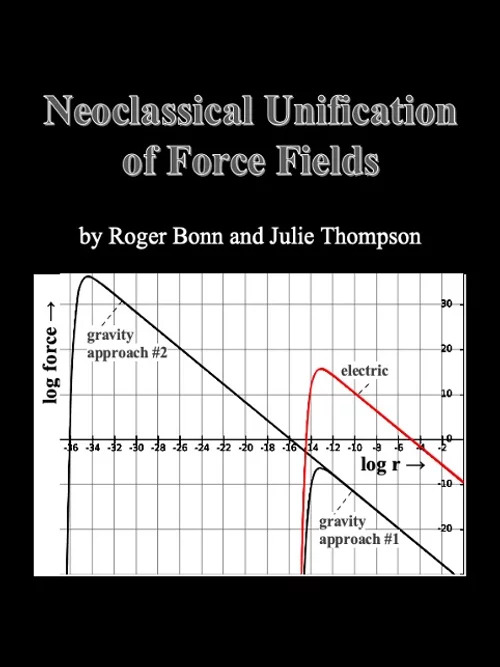
Price and availability TBD
Neoclassical Unification of Force Fields
“I have not as yet been able to deduce from phenomena the reason for these properties of gravity, and I do not feign hypotheses”. (Newton, Principia, p. 943)
Compared to any of the other known forces including the electrostatic force gravity is truly miniscule. The electrostatic force pertains to charges on electrons and protons and ultimately on ‘up’ and ‘down’ quarks. But objects made up of protons, neutrons, and electrons also have mass, and that mass is embodied in these same basic particles. So the same basic particles are responsible for electrostatic and gravitational effects. Electricity involves ‘charge’ while gravity, on the other hand involves ‘mass’, whatever those obscure properties of matter should happen to be. Since the form of these disparate forces involve identical inverse square laws. Intuitively, therefore, both forces would seem to be the effects of those basic particles themselves (if they can even be distinguished from their effects). Michael Faraday expressed this doubt very clearly as discussed on the associated page. This intuition suggests that there is but one force field pervading all space that accounts variously for virtually all of the previously compartmentalized behavior. Such intuition is essential when one is using heuristic arguments to suggest a direction for investigations to resolve difficult problems. It is these intuitions, first expressed more than 170 years ago that motivated this investigation. While motivational, intuitions themselves do not resolve any substantive issues. But it is a worthy component of any scientific investigation and not an aspect of which one should be embarrassed.
Faraday’s intuition should have resolved any confusion with regard to the basic particles of nature being the ultimate physical objects on the one hand and as mere mathematical points without associated volume on the other. As demonstrated for Gauss’s law, extensive electrostatic and gravitational ‘sources’ can be treated as though they operate through a single point to the extent that that each segment of the source is associated with inverse square law forces. The ‘center of gravity’ is a concept that also accommodates the presumption of a single mathematical point without much in the way of epistemological damage. It is also a fact that Schrödinger’s derivation of the quantum mechanical model of the atom began with the assumption of point particles for the proton and electron. But all these are mere useful artifices whose questionable validity depends ultimately on the premise of inverse square law forces and a very disingenuous treatment of the cross sections of mass and charge even within the constraint of spherical symmetry. The assumption of point particles with no mass or charge residue beyond the ‘point’ of interest is part and parcel of inverse square law forces that have been accepted as universal for both electrostatics and gravitation. We refute claims of point particles, action-at-a-distance, and precise inverse square law forces – not that they do not provide very adequate approximations at large distances from the centers of force, but because they are not valid in the vicinity of the centers themselves.
We demonstrate the effectiveness of charge and mass distributions that obtain the properties of the fundamental ‘particles’ of nature. See the summary of the approach here. These are, in fact, nothing but the ‘indivisible’ charge distributions that maintain an identity all their own by virtue of any variation in the distribution violating conservation laws as embodied in the solution of the Poisson boundary value problem. It is not a feature that can be attributed to an abstract ‘point’ particle using a Dirac delta function.
We have extended our knowledge into the domain of the unification of forces. This results in the ‘strong’ force that binds subnuclear particles which requires going to a next lower level of fundamental particles – quarks. Then the more complex nuclear creation processes will be addressed in the companion volume.